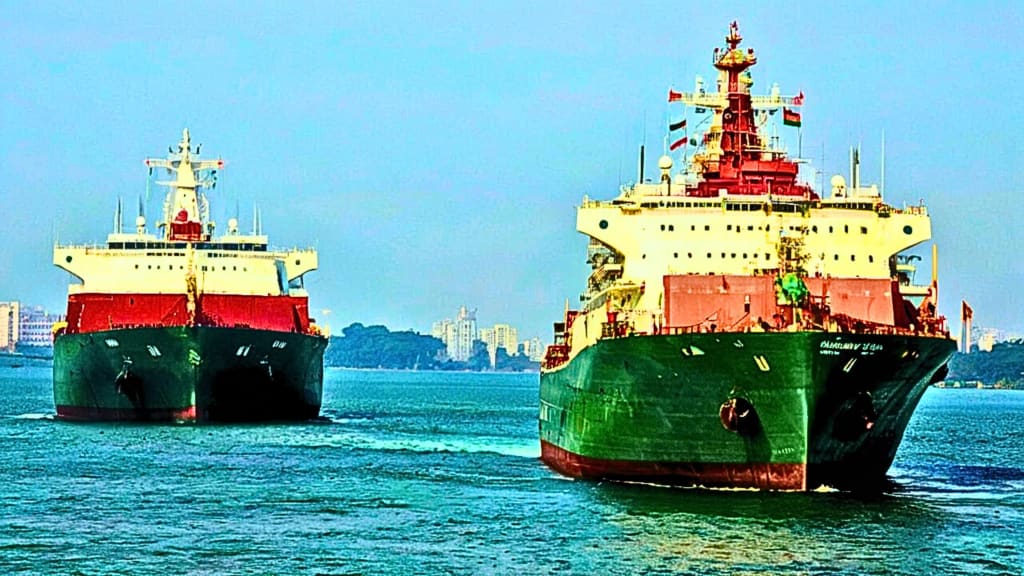Content warning
This story may contain sensitive material or discuss topics that some readers may find distressing. Reader discretion is advised. The views and opinions expressed in this story are those of the author and do not necessarily reflect the official policy or position of Vocal.
“India's Entry into the Shipbuilding Market in Bangladesh: A Game-Changer in South Asian Maritime Relations.”
Entry into the Shipbuilding Market in Bangladesh: A Game-Changer for India in South Asian Maritime Relations.

India’s recent foray into Bangladesh’s shipbuilding industry marks a significant shift in South Asian maritime dynamics. Historically dominated by China, Bangladesh's shipbuilding market has now opened its doors to Indian companies, a move that reflects broader geopolitical strategies and economic realignments in the region. This article explores the implications of this development, analyzing its impact on the shipbuilding industry, the strategic interests of India and Bangladesh, and the broader geopolitical landscape of South Asia.
Background: China's dominance of the shipbuilding industry in Bangladesh
For years, China has held a dominant position in Bangladesh’s shipbuilding sector. Chinese companies have been the primary suppliers of commercial vessels, naval ships, and spare parts, cementing a strong economic relationship between the two countries. The Chinese dominance extended beyond mere commercial interests, encompassing strategic and military dimensions as well. The Bangladeshi navy, reliant on Chinese technology and expertise, exemplified this dependence.
China's involvement was not limited to supplying ships; it also included building infrastructure and providing technical support. This extensive engagement was fueled by China's broader Belt and Road Initiative (BRI), aiming to enhance connectivity and cooperation across Asia. The BRI facilitated numerous projects in Bangladesh, further entrenching China’s influence.
The Catalyst: India’s Strategic Move into Bangladesh
India’s recent entry into the Bangladeshi shipbuilding market signifies a strategic maneuver to counterbalance China’s influence. The breakthrough came when an Indian company secured a $16 million contract with the Bangladeshi government, marking a notable victory over Chinese competitors. This contract, valued at approximately ₹127 crores, includes the construction of a specialized dredging vessel equipped with modern technology and innovative design at a competitive price.
The vessel, with a capacity of around 1000 cubic meters, is tailored for operations in Bangladesh’s coastal areas, addressing the pressing issue of land erosion and siltation. This strategic investment not only strengthens India’s economic ties with Bangladesh but also enhances its geopolitical foothold in the region.
Implications for the Shipbuilding Industry
• Economic Impact
India’s entry into the Bangladeshi shipbuilding market heralds significant economic implications. For Bangladesh, diversifying its sources for shipbuilding and maritime technology reduces dependency on a single country, fostering competitive pricing and innovation. The involvement of Indian companies introduces advanced technology and expertise, potentially boosting the overall standards of Bangladesh’s maritime sector.
For India, securing contracts in Bangladesh opens up new avenues for its shipbuilding industry. This move aligns with India’s ‘Make in India’ initiative, which aims to promote domestic manufacturing and export capabilities. By tapping into Bangladesh’s market, Indian shipbuilders can enhance their international presence and competitiveness.
• Technological Advancements
The introduction of Indian technology and design in Bangladesh’s shipbuilding sector promises significant advancements. Indian companies, leveraging modern technology and innovative designs, can offer superior quality vessels at competitive prices. This technological infusion is crucial for Bangladesh, which seeks to modernize its maritime infrastructure and enhance its naval capabilities.
• Competitive Landscape
The entry of Indian companies disrupts the existing competitive landscape, challenging Chinese dominance. This competition can lead to better pricing, improved quality, and more options for Bangladesh. Moreover, the presence of multiple suppliers can mitigate risks associated with over-reliance on a single country, ensuring more robust and resilient supply chains.
Geopolitical Dimensions
India-Bangladesh Relations
India’s successful entry into Bangladesh’s shipbuilding market symbolizes a strengthening of bilateral relations. This economic collaboration is a testament to the growing strategic partnership between the two countries. For Bangladesh, fostering closer ties with India provides a counterbalance to its relationship with China, ensuring a more diversified and balanced foreign policy.
Regional Power Dynamics
India’s strategic move has broader implications for regional power dynamics in South Asia. By increasing its presence in Bangladesh, India can counter China’s influence, promoting a more multipolar regional order. This development is in line with India's larger strategic goals of strengthening its position as a regional power and ensuring South Asian stability and security.
Impact on China
China’s established position in Bangladesh faces new challenges with India’s entry. While China remains a significant player, the competition introduced by Indian companies can erode its market share and influence. This development may prompt China to reassess its strategies and possibly adopt more competitive practices to retain its foothold in Bangladesh.
Strategic Considerations for the Future
i. Strengthening Economic Ties
For India and Bangladesh, this development is an opportunity to further strengthen economic ties. Expanding cooperation in shipbuilding can pave the way for collaborations in other sectors, fostering deeper economic integration. Joint ventures, technology transfers, and shared investments can enhance the economic synergy between the two countries.
ii. Enhancing Maritime Security
The modernization of Bangladesh’s maritime capabilities, facilitated by Indian technology, contributes to regional maritime security. A well-equipped and technologically advanced Bangladeshi navy can play a crucial role in ensuring stability in the Bay of Bengal and surrounding waters. Collaborative efforts in maritime security can enhance regional cooperation and address common challenges such as piracy, smuggling, and environmental threats.
iii. Promoting Regional Cooperation
India’s successful engagement with Bangladesh can serve as a model for promoting regional cooperation in South Asia. By fostering economic and strategic partnerships, countries in the region can collectively enhance their resilience and development. This cooperative approach aligns with India’s vision of ‘Neighbourhood First’, emphasizing regional integration and collective progress.
Conclusion: A New Era in South Asian Maritime Relations
India’s entry into Bangladesh’s shipbuilding market marks a significant milestone in South Asian maritime relations. This development is not merely an economic transaction but a strategic maneuver with far-reaching implications. For Bangladesh, it represents an opportunity to diversify it’s maritime partnerships and modernize its shipbuilding sector. It is a strategic victory for India, increasing its regional influence and competitiveness.
Two countries embark on this new chapter of cooperation, the broader geopolitical landscape of South Asia is set to evolve. The interplay of economic interests, strategic objectives, and regional dynamics will shape the future of maritime relations in the region. Ultimately, this development underscores the importance of strategic foresight, economic collaboration, and regional cooperation in navigating the complexities of South Asian geopolitics.
In conclusion, the entry of Indian companies into Bangladesh’s shipbuilding market is a testament to the evolving economic and strategic landscape of South Asia. It highlights the dynamic interplay between regional powers and the opportunities that arise from fostering collaborative partnerships. As India and Bangladesh continue to strengthen their ties, the ripple effects will be felt across the region, shaping the future of South Asian maritime relations for years to come.
About the Creator
Kaushik Rakshit
Sriting
Enjoyed the story? Support the Creator.
Subscribe for free to receive all their stories in your feed. You could also pledge your support or give them a one-off tip, letting them know you appreciate their work.






Comments (1)
Interesting and delicious content. Keep posting more now.